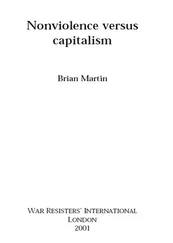In this picture, the transformation of technology to serve nonviolent action falls between the agenda of principled nonviolence, which rejects much of modern technology, and the agenda of pragmatic nonviolence, which accepts most nonmilitary modern technology. Undoubtedly, this picture is much too simple. There are, after all, many activists and scholars who support principled nonviolence without rejecting modern technology and who support pragmatic nonviolence as part of a programme for fundamental change in social structures. But perhaps there is an element of truth here that, along with other factors, has contributed to the neglect of technology for nonviolent struggle.
Another way into this field is to begin as a scientist or engineer and to become involved with nonviolence. For decades, many scientists and engineers have been involved in peace movements, but this has led to little engagement with the nonviolence movement.
Just as importantly, few scientists have linked their concerns about war and peace with a critique of science itself. Critics of science have exposed the use of science for profit and social control. [6] . See for example Hilary and Steven Rose (eds.), The Political Economy of Science: Ideology of/in the Natural Sciences (London: Macmillan, 1976) and The Radicalisation of Science: Ideology of/in the Natural Sciences (London: Macmillan, 1976); and the journals (all now defunct) Science for the People , Science for People and Radical Science Journal . Unfortunately, the critique of engineering does not boast an extensive literature.
There are several reasons why they have given so little attention to nonviolence.
The first reason is that nonviolence has a very low scholarly profile. As an intellectual tool, a critic of science might use political economy, Marxism, feminism or even postmodernism, but would be unlikely to be even aware of nonviolence theory. Few of the critics of science have been involved in campaigns where ideas and writings about nonviolence are raised.
Another reason is that most critics of science study what exists and don’t spend much time envisioning alternatives. Exposés of the corporate abuse of science abound, but there are few investigations of what science would be like under cooperative economic structures.
Finally, much of the critique of science has been undertaken from socialist perspectives, which are primarily built on a critique of capitalism. Socialists seek the end of capitalism through the capture of state power, whether in a revolution or through electoral politics. In either case, there is no rejection of the use of violence. Armed struggle — especially in Third World countries — is usually supported or reluctantly accepted as a necessity.
These are some of the reasons why there has been so little investigation of nonviolence by scientists, engineers or critics of science. The reasons presented here for the neglect of science and technology for nonviolent struggle are somewhat speculative. All that is certain is that the topic has been neglected. [7] . The reasons are harder to pin down, because there are few definite actions or motivations to investigate, as in all cases where the issue is lack of interest and lack of investigation. I think that the reasons mentioned above are plausible, and have some basis in the writings and activities of activists and scholars (though I haven’t gone into this sort of detail). By searching for explanations for neglect, it may be possible to find ways to stimulate greater interest in the topic.
So far I have presented several ways for setting priorities for science and technology for nonviolent struggle:
look at previous funding priorities (not useful, since there has been almost no prior funding);
look at actual uses of science and technology in nonviolent struggles (useful, but providing little guidance for priorities);
look at research proposals (useful, but limited in scope).
Another way to proceed is to draw up a list of areas important for engaging in struggle and then determine which scientific fields have the greatest potential of contributing in those areas. Let me first consider military struggle, for which the most obvious area is weapons. Many branches of the physical sciences and engineering are vital for this, from nuclear physics and chemistry to molecular biology.
But there are other, less obvious, areas where improved knowledge may be helpful. One important area is recruitment and retention of skilled personnel. For this, psychological and sociological studies might prove useful. Other areas important for military strength are arms manufacture, transportation, logistics, training, leadership and communication. By going through all key areas, assessing needs and then assessing which (if any) fields of science and technology might prove useful, a set of priorities can be set up for funding research and development.
Of course, there are other considerations that affect military funding for science and technology. These include financial constraints, availability of skilled and willing scientists and technologists, political support or opposition, possible civilian spinoffs and arms control treaties, among others. But the general approach, namely of listing key areas and seeing which technical fields are most useful to them, still has merit.
This approach can now be applied to social defence. The first thing to do is to list key areas important to a social defence system. This is not so easy! There is no generally accepted list, and certainly no list designed for this purpose. So, on the basis of my knowledge of social defence and in consultation with Mary Cawte, who had just read through many of the writings on social defence, I wrote down a number of areas. I then sent the list to a few social defence experts, who suggested additions. [8] . I thank Robert Burrowes in particular for useful comments.
Here is the list that resulted from this process.
Key Factors in a Social Defence System
Active factors
Psychological and organisational factors
• morale, unity, will
• knowledge, education, understanding, analysis, strategy, tactics, evaluation
• coordination, decision-making, organisation, leadership
Physical infrastructure
• communication
• survival: food, water, clothing, shelter, energy, transportation, health
• industry, production, economics
Other factors
• skills
• self-reliance
• allies
• constructive programme (building a nonviolent society)
Reactive factors (including direct disarmament [9] . Direct disarmament is the disabling and dismantling of weapons by people without the permission of governments and commanders.
)
• anti-nuclear weapons (countering the threat and effects of nuclear weapons)
• anti-biological weapons
• anti-chemical weapons
• anti-conventional weapons.
* * *
It is impossible to give weights to these factors in terms of their importance, since there is no theoretical framework available for this purpose. Nevertheless, a general ranking is possible by looking at studies of nonviolent struggles. Undoubtedly the greatest attention is given to psychological and organisational factors, as suggested by the 24 Dutch social defence research proposals.
The priority given to psychological and organisational factors also can be illustrated by examining the views of writers on social defence who have examined the centre of gravity, a key concept proposed by the classic military strategist Carl von Clausewitz. [10] . Carl von Clausewitz, Vom Kriege [On War] (Berlin: Ferdinand Dümmler, 1832). The following paragraphs on the centre of gravity are taken from Brian Martin, “Social defence strategy: the role of technology,” Journal of Peace Research, Vol. 36, No. 5, 1999, pp. 535-552.
Читать дальше












